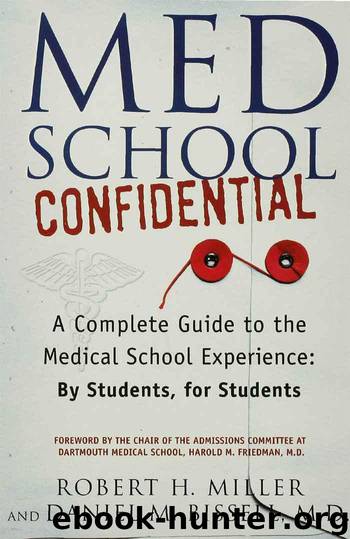Med School Confidential: A Complete Guide to the Medical School Experience: By Students, for Students by Miller Robert H. & Bissell M.D. Dan

Author:Miller, Robert H. & Bissell M.D., Dan [Miller, Robert H.]
Language: eng
Format: azw
ISBN: 9780312330088
Publisher: St. Martin's Griffin
Published: 2010-03-31T16:00:00+00:00
A STUDY TECHNIQUE TOOLBOX
Here’s a quick list of tools the mentors used to build their knowledge base in medical school. You may want to consider adopting them as well.
Flash cards
Mnemonics (the raunchier the better!)
Diagrams and drawings
Old tests for sample questions
Revising and rewriting your notes
Commercial course outlines and reviews
Listening to taped lectures and reviewing prepared noteservice notes
CHAPTER 13
The First Year: Normal Systems
Our own physical body possesses a wisdom which we who inhabit the body lack.
—HENRY MILLER
THE FIRST-YEAR CURRICULUM is all about understanding how the human body is supposed to work. Much of this material will seem a long way from any clinical application, but it will provide a critical context for the classes to come. Your core anatomy training will include Embryology, Human Gross Anatomy, Cellular Biology, and Histology. Mastering these classes will require that you learn a completely new language of anatomical terminology while at the same time developing a multidimensional sense of spatial and structural relationships of the different pieces and parts. Not an easy undertaking, but it’s fascinating stuff. Your Anatomy course will doubtless be an experience you will recall for the rest of your life. The rigors of managing such a staggering volume of information, the challenges of surviving new classes with new classmates, and the emotional impact of dissecting a human being will inevitably leave an indelible mark.
Your core physiology training will focus on developing an understanding of the function of individual organ systems and the overall symbiotic function of the body. Course work here will likely include Human Physiology, Biochemistry, Genetics, and Nutrition. It is, for obvious reasons, vitally important that you understand completely the normal function of the human body before you can begin to address the impact and management of disease—and that’s the rationale for the organization of the traditional curriculum. Your course work here will build on your growing understanding of anatomy and yield functional insights. The human body is an intensely dynamic machine, and an appreciation of physiology in action is truly awe-inspiring.
Download
This site does not store any files on its server. We only index and link to content provided by other sites. Please contact the content providers to delete copyright contents if any and email us, we'll remove relevant links or contents immediately.
| Dictionaries & Terminology | Drug Guides |
| Education & Training | Instruments & Supplies |
| Medical Atlases |
Periodization Training for Sports by Tudor Bompa(8215)
Why We Sleep: Unlocking the Power of Sleep and Dreams by Matthew Walker(6659)
Paper Towns by Green John(5141)
The Immortal Life of Henrietta Lacks by Rebecca Skloot(4552)
The Sports Rules Book by Human Kinetics(4348)
Dynamic Alignment Through Imagery by Eric Franklin(4179)
ACSM's Complete Guide to Fitness & Health by ACSM(4021)
Kaplan MCAT Organic Chemistry Review: Created for MCAT 2015 (Kaplan Test Prep) by Kaplan(3972)
Introduction to Kinesiology by Shirl J. Hoffman(3744)
Livewired by David Eagleman(3730)
The Death of the Heart by Elizabeth Bowen(3581)
The River of Consciousness by Oliver Sacks(3574)
Alchemy and Alchemists by C. J. S. Thompson(3484)
Bad Pharma by Ben Goldacre(3397)
Descartes' Error by Antonio Damasio(3250)
The Emperor of All Maladies: A Biography of Cancer by Siddhartha Mukherjee(3114)
The Gene: An Intimate History by Siddhartha Mukherjee(3075)
The Fate of Rome: Climate, Disease, and the End of an Empire (The Princeton History of the Ancient World) by Kyle Harper(3035)
Kaplan MCAT Behavioral Sciences Review: Created for MCAT 2015 (Kaplan Test Prep) by Kaplan(2960)
